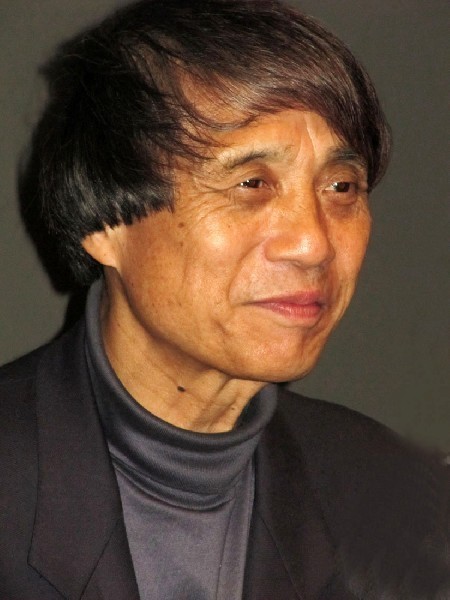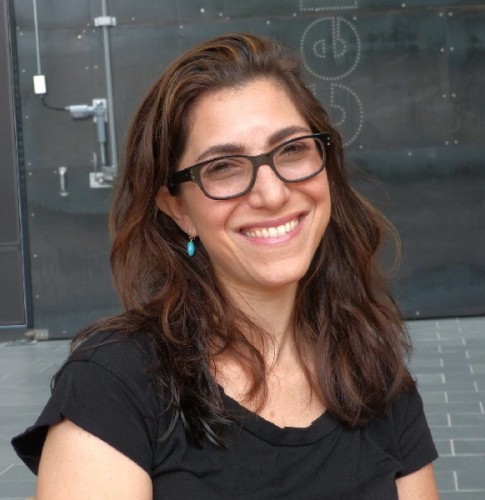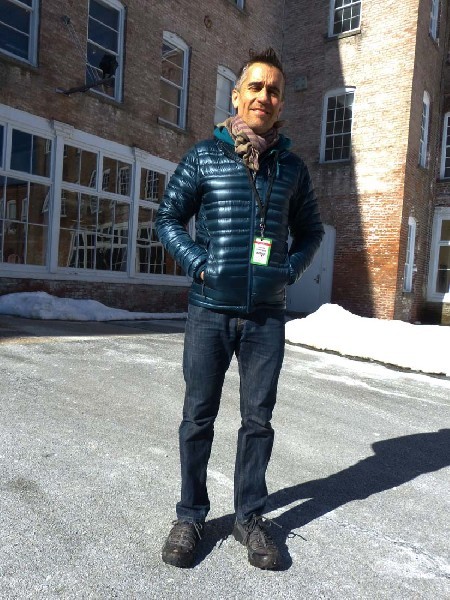Joe Thompson Expansion Part Two
Economic Impact and Wish Lists
By: Charles Giuliano - Mar 10, 2014
Charles Giuliano Going back to Tom Krens and his original idea of showing the collection of Count Panza there are surely numerous collectors with vast and growing warehouses of work. In a number of instances that has morphed them into forming their own museums or allowing occasional VIP visits to their homes and storage facilities.
One assumes that there are a number of individuals with mega holdings looking at MoCA as a potential solution to getting their collections out of storage and on view. Instead of the cost and effort of building and maintaining private museums that facility is already operational here.
That would seem to put you in the position of making interesting and difficult choices.
Joe Thompson Yeah. You got it.
Over the past 20 years there have been a very large number of great collections formed. The flip side of the One Percent problem is that great collections are almost always formed by individuals. They are rarely formed by committees at museums. Museums get great collections by being gifted. The last great period that we have seen that is equivalent to the creation of wealth is the 1920s in the United States. It’s no accident that in the next few decades a lot of those collections ended up in the public domain.
CG Without naming names can we assume that those conversations are happening?
JT Yes. They are. We’re working on those. Yes.
CG Are you narrowing the wish list?
JT We are. We’re talking to three or four or five potential partners. They won’t all happen. I feel we’re getting close to a couple of them. The timing feels about right. We’ll have another five or six months of work to do. So about when we’re ready to get into design and development we’ll be ready to announce what the next partnerships will entail.
CG Who has the upper hand? Who is wooing whom? Are you the bride or the groom?
JT We have what we have. We have beautiful and economical space. We have a great audience. We have a really interesting cultural neighborhood. We have the Clark. I’m really excited about their expansion opening this summer. We have Williams College. We have the whole intellectual human resources with the graduate program at the Clark. The conservation lab. The great art history program at Williams College. The growing arts administration program at MCLA. As you know there are a surprising number of art historians and individuals whose lives are involved in the arts. We have the highest per capita number of arts writers and art historians of any place in the country if you look at Williamstown and North Adams. Look at all the faculty, writers and critics, studio professors and graduate students. It’s a remarkable depth.
That’s what we have. The Berkshires in a broad sense. People come for Tanglewood and Jacob’s Pillow. That’s what we offer.
What we don’t have is that we’re not downtown New York or Boston or downtown Montreal. Or Los Angeles.
With out fit in the Berkshires we’re a very strong place to consider. There are always people who drift to urban areas. So there is always a certain amount of filtering that happens.
CG Going back to the beginning. Before God separated the night from the day. This was all about economic development for Northern Berkshire County the most depressed region of Massachusetts. You have stated that when you started the Mass MoCA project the unemployment rate was seven times that of the rest of the state. Currently it is twice as much. So there has been progress but this region remains relatively poor. Local citizens want to know is this new phase of expansion and programming going to put money in my pocket?
Your press release projects an increase of visitation of some 60,000 annually. The Clark is reopening this summer. MoCA has now added Kiefer to the LeWitt installation. One assumes that will be a magnet for more visitors. Add to that mix the Williams College Museum of Art and a revitalized Williamstown Theatre Festival in the final season organized by Jenny Gersten. Can you crunch some numbers for me?
JT Yes I can. There are two things you have to keep your mind on.
With the combination of new programs and new collections, bigger space at the Clark, there will definitely be more people coming to Williamstown and North Adams. I have no doubt about that. Is it going to be 40,000 or 80,000 additional people? Who really knows? Our best estimate based on what happened after LeWitt, Kiefer and just watching our numbers over the past fifteen years is that there will probably be an increase of 50,000 to 60,000 people.
That’s with the clear idea that the Clark is going to reopen with something really exciting. The actual numbers are important but not the most important factor. Having more people come is important but the key is how long will they stay. (Clark director Michael Conforti on an expanded role for contemporary art.)
If you just have another 50,000 people making day trips down from Manchester or up from Northern Connecticut. Well people drive in and maybe they grab lunch. Fill up the car and head back to wherever they’re going.
With the Clark reopening this summer, and the exposure of all their beautiful grounds, and the new (Tadeo Ando) architecture, the reflecting pools, the new galleries. The Clark where it used to be perfectly comfortable to visit for an hour or two, that’s not going to be possible anymore. It will be easy to spend a half day or even a day enjoying the new galleries and new architecture.
Likewise when we first opened Mass MoCA was an easy one hour or two hour visit. Adding LeWitt and Kiefer, as well as increased use of our outdoor grounds, has made it difficult to get in and out of here in two hours.
If we do this Building Six expansion and add another 120,000 square feet it will also become a half day or even a full day experience. People will want to take time and get a cup of coffee.
And you’ve got the Williams College Museum of Art.
My point is that three years out when all this comes together, and also the Williamstown Theatre Festival, it becomes really difficult to take it all in within a day. The key then will be to extend people’s visits to two and even three days. Long weekends.
When you start shifting our visitation from day-tripping to overnights the economic dividend multiplies greatly. Once people spend the night they’re not having one meal they’re having three. Or six. Then there’s more need for lodging and bed and breakfast. That’s the dynamic for us to keep an eye on. That’s one of the goals here.
CG There is also the factor of impact on real estate. Recently I met with Darren Waterston who is doing a MoCA installation. He is actually a neighbor and has been living in the Eclipse Mill (40 unit artist lofts residence) since July. I asked him about a rumor that he was interested in buying a loft. He said that he would love to but has a studio and mortgage in New York. Stephen Hannock is an established artist who lives and works here. Would you expect that North Adams/ Williamstown will be of greater interest for mid career and established artists?
Given the availability of affordable real estate is there the possibility that MoCA would purchase residential and studio property toward the goal of establishing an artists residency program? Like having Waterston here for a number of months.
When Wilco comes with the Solid Sound Festival you put them up in Porches.
JT We own a couple of houses. We house as much as 30 people mostly interns. We also use them for artist residencies. Darren is a point well taken. It’s unusual that it was such an extended visit. Have you seen his work yet?
CG We saw it as a work in progress and have yet to see it as finished.
JT Wait till you see it. It’s amazing. It is one of the most fabulous, fabulous things we’ve ever done here. Really beautiful. The detail. It’s detailing. It’s stained glass. Really beautiful painting.
CG It’s interesting to talk about his residency. Coming here and living in an artists’ building. To some extent he’s so busy you just see him walking his dogs. But he is a real presence in the community. Mostly artists come and go and have little or no interaction with our arts community.
JT That’s true and very interesting. He’s moved in and become a part of the community. In large part that’s because of the duration. Several months. Where our more typical residency tends to be three to five weeks. It’s been a lot of fun. Our staff has really enjoyed getting to know him.
CG Knowing that it is very intense while artists are working on installations is there a way in which there might be greater interaction with the local arts community? For example setting aside a couple of hours for the arts community to visit the work in progress and have a dialogue with the artist?
JT That’s a great idea. We have done bits and pieces of it with artist’s talks. To take a couple of hours out to have wine and cheese. To talk and has a social level and intellectual engagement. To bring them in. That’s a great idea. We haven’t done a lot. We’ve done it in fits and starts. It hasn’t been systematic.
CG There’s a sociological aspect. Regarding MoCA in the local artist community there is a feeling of Us vs. Them. There’s that big monolith over there and I’m the little guy over here. I’m just trying to scratch out a living and doing my work.
It would be good to build bridges between the museum and the arts community. Often when we attend openings and events we look around and are disappointed by the relatively light attendance of our neighbors. There was a good turnout when MoCA hosted the launch of an Open Studios weekend. If there was imaginative programming that might change.
JT If they met them (artists) before they would (come to openings).
CG Exactly. I think a lot of our neighbors will come to Darren’s opening because they have seen him for the past months and will be curious.
JT They’re not going to be disappointed. He would probably be quick to describe himself as an artist scratching it out too. He was a cold call for us. He sent us his portfolio over the transom. We get about a thousand of those a year. We look at them all. Susan (Cross) saw this and really liked the work. She thought it would be a great project for the Hunter Foyer. When she actually saw the work Susan said no let’s do a painting show. He said “Actually I’ve had this other idea in the back of my head.” He described his wild riff on Whistler’s Peacock Room. We all got together and chatted and said, yeah, do you think we can actually build that sucker? (laughs)
That’s how the project was born. It went from a cold call, here I am, Darren Waterston. I want a chance to show in your museum. It became one of our most intensive residencies. It’s not the largest in terms of physical space. In terms of density and detailing it’s right at the top. Wait till you see it.
CG He also talked about staffing the project with local artists.
JT That’s right he found a lot of his assistants here.
CG To be fair Mary Lum who lives in our building has shown at Mass MoCA. When he was here Danny O showed at the museum. Stephen Hannock has previewed work with the museum. So there have been isolated instances of artists from this region showing in the museum. There is the annual high school art exhibition which has been shared with the Eclipse Mill Gallery. (Initiated by Phil Sellers) So there have been isolated instances.
Of course every contemporary art institution has this issue. What is the relationship between the museum and local artists? During the David Ross years the ICA had a series of annual Boston Now exhibitions. The equivalent of that is their current Foster Prize series. The MFA has an uneven history with its Maud Morgan Prize for mid career women artists.
JT Yeah.
CG In this next phase of expansion perhaps Mass MoCA can come around to addressing some of those issues.
JT That’s a good point.
CG I’m not sticking a finger in your eye.
JT That’s ok. I can take it. (both laugh)
CG What are you looking forward to this summer? Is the Clark finally going to come and develop their building on the MoCA campus?
JT I don’t know. That’s question for them. First they have to digest this massive undertaking that they have been doing. The truth of the matter the original plan was that they were going to jump start that project by doing a renovation here. They would use this for office space and a pied a terre while they were under construction. They would have storage and maybe do a little bit of public programming. To have some accordion space to come into. The other project got larger and bigger and faster. It became all consuming and their energy and resources got sucked into that project putting this project on hold. I suspect that once they open and have a chance to breathe a little bit then they’ll turn their attention back here. To have two fronts open at the same time became too much.
CG Coming back to the idea of initiating an artists’ residence program. The Clark has an advanced and sophisticated program with visiting art historians and scholars. They have access to one of the finest research resources in the nation. They do superb programming of lectures and colloquia with those scholars. You bring in artists for projects.
JT You’re describing something in between. We’ve actually had talks with the Clark about commonalities. Our residencies are all about fabricating new works that are then on display to the public. It’s not a retreat but rather an advance. Come and make work and show it. It’s not speculative. It’s not a typical artist retreat. Where there is time to think and develop ideas. To be in an intellectual milieu. It’s not what we focus on. It’s about making things here. But the Clark does more research and development work and it could be a really interesting mix to do something together.
CG Add to that Williams College.
JT Exactly.
CG Darren, for example, has been teaching a course at Williams. If you pooled resources for a residency program and perhaps acquired affordable studio and residential property that could be unique and powerful.
To be frank the local arts community needs to be brought into the 21st century and its matrix of global issues and ideas. Creating ready and sustainable synergy would have a measurable long term impact. So we are talking about an educational process.
JT It’s a two way street.
CG If you attend MoCA events there are some amazing individuals, like the volunteer, Evelyn, who have really engaged with the museum. These are people for whom, without Mass MoCA, the arts would not be a significant part of their lives. When we are out in the community, getting our hair cut, our car repaired, shopping and dining, we constantly encounter people who have never set foot on the campus. This week the young woman cutting my hair said that she loved seeing Wilco. We had a lively dialogue about what than event meant to her.
Thanks so much for your time.
JT Let’s talk again in a couple of months when this is real. I don’t want to jinx it. We’ll have to watch and see how it unfurls. It’s going to be an exciting month or two.
Thompson Part One.







